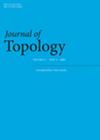一个定量Birman-Menasco有限定理及其在交叉数上的应用
IF 0.8
2区 数学
Q2 MATHEMATICS
引用次数: 2
摘要
Birman-Menasco证明了有有限多个结点具有给定的属和编织指数。我们给出了Birman-Menasco有限定理的一个定量版本,用格数和编织指数估计结的交叉数。作为应用,我们给出了确定给定链路的编织指数问题的解,并给出了连通和或卫星交叉数的估计。本文章由计算机程序翻译,如有差异,请以英文原文为准。
A quantitative Birman–Menasco finiteness theorem and its application to crossing number
Birman–Menasco proved that there are finitely many knots having a given genus and braid index. We give a quantitative version of the Birman–Menasco finiteness theorem, an estimate of the crossing number of knots in terms of genus and braid index. As applications, we give a solution of the braid index problem, the problem to determine the braid index of a given link, and provide estimates of the crossing number of connected sums or satellites.
求助全文
通过发布文献求助,成功后即可免费获取论文全文。
去求助
来源期刊

Journal of Topology
数学-数学
CiteScore
2.00
自引率
9.10%
发文量
62
审稿时长
>12 weeks
期刊介绍:
The Journal of Topology publishes papers of high quality and significance in topology, geometry and adjacent areas of mathematics. Interesting, important and often unexpected links connect topology and geometry with many other parts of mathematics, and the editors welcome submissions on exciting new advances concerning such links, as well as those in the core subject areas of the journal.
The Journal of Topology was founded in 2008. It is published quarterly with articles published individually online prior to appearing in a printed issue.
 求助内容:
求助内容: 应助结果提醒方式:
应助结果提醒方式:


